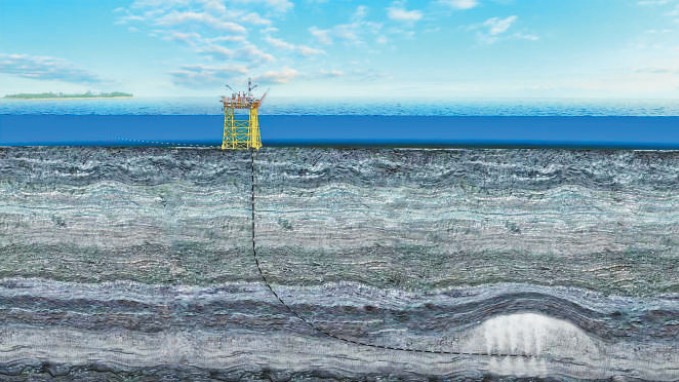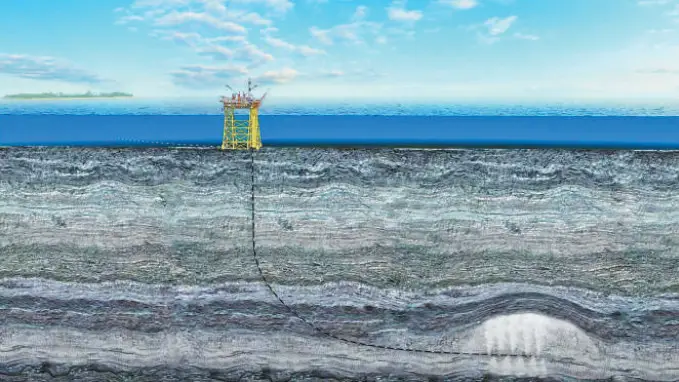By Ran Yongping, Ding Yiting, People's Daily

Photo shows a schematic of China's offshore carbon storage project. (Photo provided by the China National Offshore Oil Corporation)
China's first offshore carbon storage project was put into operation on June 1 in the South China Sea.
With an annual capacity of 300,000 tons, the project is designed to store a total of more than 1.5 million tons of carbon dioxide(CO2), which is equivalent to planting nearly 14 million trees.
The operation of the project signifies China's achievement in acquiring a complete set of technologies and equipment for capturing, processing, injecting, storing and monitoring (CO2) at sea.
The project, serving the Enping 15-1 oil platform 200 km southwest of Shenzhen, south China's Guangdong province, captures and processes CO2 from oilfields and then injects CO2 into a "dome" geological structure at a depth of around 800 meters under the seabed and about 3 km from the platform.
What needs to be done to inject CO2 into the seabed strata?
Firstly, a location appropriate for storage shall be found. The "dome" geological structure discovered by Chinese experts, which resembles a massive bowl, is a natural "can" that is able to hold CO2 stably and perpetually.
After the location is decided, a 900-meter-deep extended-reach well with a displacement of over 3,000 meters needs to be drilled so that CO2 can be transmitted to the "dome" geological structure.
Given such a huge displacement, the friction on the sidewall of the well is expected to multiply, so the drill would probably stuck inside the well. In addition, the well is prone to collapse and drilling fluid loss because of the loose soil under the seabed.
To cope with these challenges, drilling experts tailored anti-corrosion drilling fluid that's able to support the sidewall and moisture the well, which makes the injection of CO2 unimpeded.
Besides, a fiber optic monitoring system has been installed to the CO2 injection tube, with a monitoring point every one meter along it. A total of thousands of monitoring points are there to see if the tube is leaked.
China's sea areas boast a wide distribution of sedimentary basins, thick strata and a large number of structural traps, which creates a sound environment for the storage of CO2.
The potential CO2 storage capacity in the country's sea area is estimated to be 2.58 trillion tons, offering important support for the country to reach its "dual carbon" goal of peaking carbon dioxide emissions by 2030 and achieving carbon neutrality by 2060.
With an annual capacity of 300,000 tons, the project is designed to store a total of more than 1.5 million tons of carbon dioxide(CO2), which is equivalent to planting nearly 14 million trees.
The operation of the project signifies China's achievement in acquiring a complete set of technologies and equipment for capturing, processing, injecting, storing and monitoring (CO2) at sea.
The project, serving the Enping 15-1 oil platform 200 km southwest of Shenzhen, south China's Guangdong province, captures and processes CO2 from oilfields and then injects CO2 into a "dome" geological structure at a depth of around 800 meters under the seabed and about 3 km from the platform.
What needs to be done to inject CO2 into the seabed strata?
Firstly, a location appropriate for storage shall be found. The "dome" geological structure discovered by Chinese experts, which resembles a massive bowl, is a natural "can" that is able to hold CO2 stably and perpetually.
After the location is decided, a 900-meter-deep extended-reach well with a displacement of over 3,000 meters needs to be drilled so that CO2 can be transmitted to the "dome" geological structure.
Given such a huge displacement, the friction on the sidewall of the well is expected to multiply, so the drill would probably stuck inside the well. In addition, the well is prone to collapse and drilling fluid loss because of the loose soil under the seabed.
To cope with these challenges, drilling experts tailored anti-corrosion drilling fluid that's able to support the sidewall and moisture the well, which makes the injection of CO2 unimpeded.
Besides, a fiber optic monitoring system has been installed to the CO2 injection tube, with a monitoring point every one meter along it. A total of thousands of monitoring points are there to see if the tube is leaked.
China's sea areas boast a wide distribution of sedimentary basins, thick strata and a large number of structural traps, which creates a sound environment for the storage of CO2.
The potential CO2 storage capacity in the country's sea area is estimated to be 2.58 trillion tons, offering important support for the country to reach its "dual carbon" goal of peaking carbon dioxide emissions by 2030 and achieving carbon neutrality by 2060.
 Menu
Menu
 China puts into use first offshore carbon storage project
China puts into use first offshore carbon storage project
















